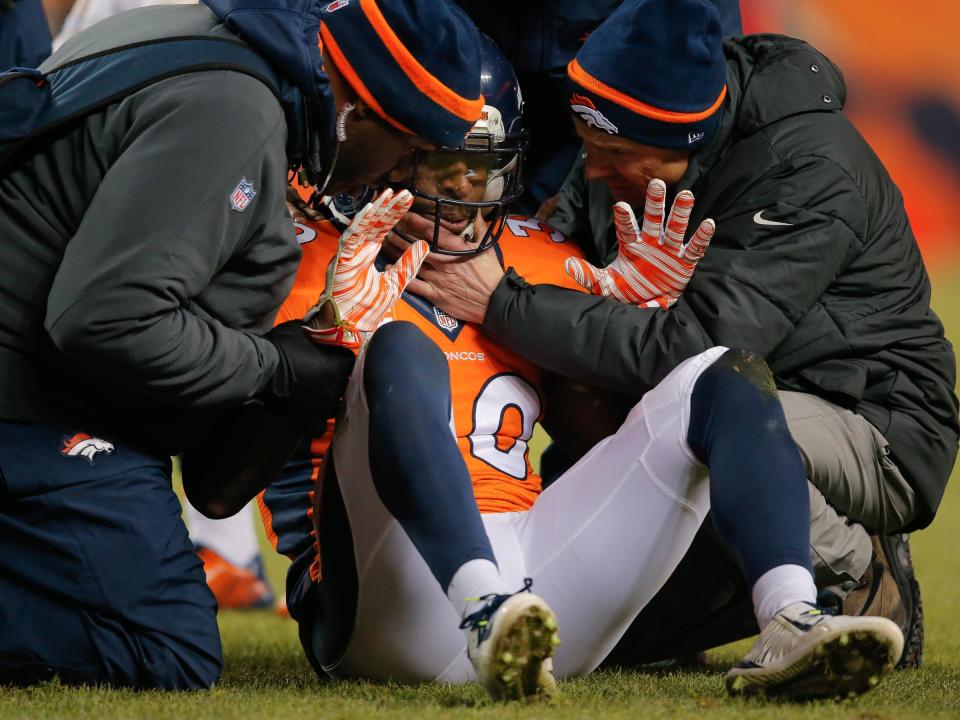Aaron Hernandez had a severe form of the brain disease that impacts a wide swath of NFL players — here's what it does

Steven Senne/AP
Aaron Hernandez, the former New England Patriots tight end and a convicted murderer who killed himself in April at age 27, had a severe form of a degenerative brain disease ubiquitous among football players.
A recent exam showed that his CTE, short for chronic traumatic encephalopathy, was so advanced that it resembled damage that scientists have seen in players twice his age, the New York Times reported.
CTE is strongly linked to repeated blows to the head.
A recent study published in the Journal of the American Medical Medical Association revealed that out of 202 deceased American football players, 177 showed signs of CTE. The results were even more stark for former NFL players. One hundred and ten out of 111 of them — or 99% — were diagnosed with the disease.
The symptoms of CTE vary widely depending on how advanced or severe it is, but people may experience memory problems, mood disorders, depression, lapses in judgment, and dementia.
Hernandez' life — a roller coaster of tragedy and stardom — was checkered with erratic, paranoid, and impulsive behavior. Researchers now have a new reason to suspect that CTE could have played a role in some of that.
The NFL has been accused of denying or concealing the risks of head injuries in the past, which led to a $1 billion lawsuit between the league and thousands of former players. Football players like Junior Seau and Dave Duerson, who both killed themselves, asked that their brains be examined for signs of the disorder and were diagnosed with CTE after their deaths.
Chris Nowinski, the executive director of the Concussion Legacy Foundation and author of "Head Games: The Global Concussion Crisis," previously told Business Insider that it's hard to understand just how bad this sort of disease can be "until you live this every day and really hear the horror stories of what happens to families when things go wrong."
What we know about CTE and the brain
The longer and more seriously someone played football, the study found, the more likely they were to have severe CTE. People who stopped playing after high school all had mild pathology, while those who played in college, semiprofessional, and professional leagues mostly had severe CTE.
Even the individuals posthumously diagnosed with "mild" CTE showed signs of behavior problems, cognitive issues, and mood disorders when they were alive. Substance use disorders, a likelihood of taking their own lives, and impulsivity were also common. In addition to those traits, those with severe CTE were frequently diagnosed with dementia.
"It is no longer debatable whether or not there is a problem in football — there is a problem," Dr. Ann McKee, who led the study, told The New York Times in July. Even if CTE was expected to be somewhat common, the fact that 99% of NFL players in the study showed signs of the disease indicates that it's prevalent among former players.

Doug Pensinger/Getty Images
The brains that BU's CTE Center studied were all donated for research based on suspicions that the individuals they once belonged to might have developed the disorder. Unfortunately, CTE can only be diagnosed after death, but many of the players whose brains were examined displayed symptoms before death that are linked to the disorder.
So it's not a surprise that CTE was so common among this sample.
However, as the Times reports, approximately 1,300 former NFL players have died since the CTE Center began this research. Even if zero of the brains that were not examined in this study showed signs of CTE, that would still make the minimum CTE prevalence for former NFL players approximately 9%. That still seems high for a condition not frequently diagnosed in the general population. And it's likely the incidence is even higher than that.
What we still don't know
The NFL has already admitted that there's a link between playing football and developing CTE. But we still don't know what causes CTE in the first place.
It's possible that concussions, the bell-ringing hits that leave players confused and potentially knocked out, play a role. But it's perhaps even more likely that the degenerative condition is triggered by the hundreds or thousands of smaller hits to the head that players endure.
As the new study points out, the vast majority of football players aren't college or professional players. Most people who play football play at some point as kids or high school students but then stop. We don't yet know how risky that exposure is, but it could be dangerous.
"It's an ethical question, what is our culture comfortable with," Nowiski told Business Insider. "Is government underwriting brain damage for children through school sports?"
Oher sports may be risky as well. CTE was first identified as "dementia pugilistica" in former boxers, and at least one study found that 17% of former boxers' brains showed the disease. Concerns have also been raised about the consequences of heading the ball in soccer and about contact sports like hockey and rugby.
It's important to understand these overall risks and to compare them to the health and social problems associated with avoiding sports. Perhaps the games can be changed in ways that make them less dangerous — youth football leagues have already made an effort to do boost safety and have reduced concussion rates. But how do we decide when an activity is safe enough?
No one wants to suffer the effects of a degenerative brain disorder. If there's a way to help athletes avoid that, we need to figure out the best way to do so.
NOW WATCH: Here's how Tom Brady — one of the NFL's richest stars — makes and spends his millions
See Also:

 Yahoo News
Yahoo News 
